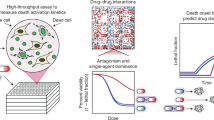Summary
The cytotoxicity of hydroxyurea in combination with 2,2′-bipyridyl-6-carbothioamide (a potential inhibitor of ribonucleotide reductase) on P388 murine leukemia is reported. Synergistic activity was studied using various interpretations of the isobologram method and the combination index method. We evaluated the pros and cons of these methods and their overall usefulness. In our opinion, to obtain all possible information from a compound association, it is important to choose a formally correct method that (a) can quantitatively evaluate synergism or antagonism, (b) may offer the possibility of averaging final results, (c) needs a minimal amount of experimental data, and (d) is rapid. Moreover, we emphasize both the utility of testing at least three molar ratios of compound association and the importance of carefully choosing the fractional inhibition used in calculating the combination effect. Such evaluation of drug combinations gives information essential to the preparation of new anticancer drug regimens and to the early assessment of biochemical interactions.
Similar content being viewed by others
References
Antonini I, Claudi F, Cristalli G, Franchetti P, Grifantini M, Martelli S (1981)N*-N*-S* tridentate ligand system as potential antitumor agents. J Med Chem 24: 1181
Asantila T, Toivanen P (1974) Potentation by fluorodeoxyuride of125deoxyuridine uptake by human and chicken lymphocytes in the quantitation of mitogenic response. J Immunol Methods 6: 73
Berenbaum MC (1981) Criteria for analyzing interactions between biologically active agents. Adv Cancer Res 35: 269
Berenbaum MC (1985) The expected effect of a combination of agents: the general solution. J Theor Biol 114: 413
Chang TT, Gulati S, Chou TC, Colvin M, Clarkson B (1987) Comparative cytotoxicity of various drug combinations for human leukemic cells and normal hematopoietic precursors. Cancer Res 47: 119
Chou TC (1976) Derivation and properties of Michaelis-Menten type and Hill type equations for reference ligands. J Theor Biol 39: 253
Chou TC (1977) On the determination of availability of ligand binding sites in steady-state systems. J Theor Biol 65: 344
Chou TC, Talalay P (1981) Generalized equations for the analysis of inhibitions of Michaelis-Menten and higher-order kinetic systems with two or more mutually exclusive and nonexclusive inhibitors. Eur J Biochem 115: 207
Chou TC, Talalay P (1984) Quantitative analysis of dose-effect relationships: the combined effects of multiple drugs or enzyme inhibitors. Adv Enzyme Regul 22: 27
Cristalli G, Franchetti P, Nasini E, Vittori S, Grifantini M, Barzi A, Lepri E, Ripa S (1988) Metal(II) complexes of 2,2′-bipyridyl-6-carbothioamide as anti-tumor and anti-fungal agents, Eur J Med Chem 23: 301
Damon LE, Cadman EC (1988) The metabolic basis for combination chemotherapy. Pharmacol Ther 38: 73
Durand RE, Goldie JH (1987) Interaction of etoposide and cisplatin in an in vitro tumor model. Cancer Treat Rep 71: 673
Fodstad O, Pihl A (1980) Synergistic effect of Adriamycin and ricin on L1210 leukemic cells in mice. Cancer Res 40: 3735
Greco WR (1987) The assessment of synergism, antagonism and additivity: a unified optimal approach (abstract). Proc Annu Meet Am Assoc Cancer Res 28: 426
Hussey H, Abrahams JP (1975) Combined therapy in advanced head and neck cancer: hydroxyurea and radiotherapy. Progr Clin Cancer 6: 79
Kano Y, Ohnuma T, Okano T, Holland JF (1988) Effects of vincristine in combination with methotrexate and other antitumor agents in human acute lymphoblastic leukemia cells in culture. Cancer Res 48: 351
Kennedy BJ (1972) Hydroxyurea therapy in chronic myelogenous leukemia. Cancer 29: 1052
Lien EG (1987) Ribonucleotide reductase inhibitors as anticancer and antiviral agents. Prog Drug Res 31: 101
Loewe S (1928) Die Quantitation-Probleme der Pharmakologie. Ergeb Physiol 27: 47
Loewe S (1953) The problem of synergism and antagonism of combined drugs. Arzneimittelforsch 3: 285
Menconi E, Lepri E, Bonmassar E, Frati L, Barzi A (1986) An in vitro assay for evaluating chemosensitivity of leukemia cells: preclinical studies. Int J Tiss React 8 (6): 485
Sato A, Cory JG (1981) Evaluation of combinations of drugs that inhibit Ehrlich tumor cell ribonucleotide reductase. Cancer Res 41: 1637
Sato A, Bacon PE, Cory JG (1984) Studies on the differential mechanisms of inhibition of ribonucleotide reductase by specific inhibitors of the non-heme iron subunit. Adv Enzyme Regul 22: 231
Satyamoorthy K, Chitnis M, Basrur V (1986) Sensitization of P388 murine leukemia cells to hydroxyurea cytotoxicity by hydrophobic iron-chelating agents. Anticancer Res 6: 329
Satyamoorthy K, Chitnis M, Basrur V, Advani SH (1986) Potentiation of hydroxyurea cytotoxicity in human chronic myeloid leukemia cells by iron-chelating agent. Leukemia Res 10(11): 1327
Steel GG (1979) Terminology in the description of drugradiation interactions. Int J Radiat Oncol 5: 1145
Steel GG, Peckham MJ (1979) Exploitable mechanisms in combined radiotherapy-chemotherapy: the concept of additivity. Int J Radiat Oncol 5: 85
Tsai CM, Gazdar AF, Venzon DJ, Steinberg SM, Dedrick RL, Mulshine JL, Kramer BS (1989) Lack of in vitro synergy between etoposide andcis-diamminedichloroplatinum (II). Cancer Res 49: 2390
Venditti JM, Goldin A (1964) Drug synergism in antineoplastic chemotherapy. Adv Chemother 1: 397
Wampler GL, Carter WH Jr, Williams VR (1978) Combination chemotherapy: arriving at optimal treatment levels by incorporating side effect constraints. Cancer Treat Rep 62(3): 333
Webb JL (1963) Enzyme and metabolic inhibitors. Academic Press, New York, vol. 1, pp 66, 488
Author information
Authors and Affiliations
Additional information
Supported in part by MPI (40%) and CNR (Special Project Oncology) contract 8702684.44
Rights and permissions
About this article
Cite this article
Nocentini, G., Barzi, A. & Franchetti, P. Implications and problems in analysing cytotoxic activity of hydroxyurea in combination with a potential inhibitor of ribonucleotide reductase. Cancer Chemother Pharmacol 26, 345–351 (1990). https://doi.org/10.1007/BF02897291
Received:
Accepted:
Issue Date:
DOI: https://doi.org/10.1007/BF02897291




